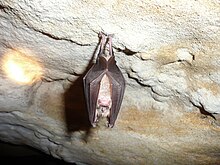Devil's Chapel Scowles
51°44′18″N 2°34′17″W / 51.738266°N 2.571262°W / 51.738266; -2.571262


Devil's Chapel Scowles (grid reference SO606045) is a 44.79-hectare (110.7-acre) biological Site of Special Scientific Interest in Gloucestershire, notified England, in 1998.[1][2] The site lies in the Forest of Dean and has four units of assessment by Natural England.[3]
Scowles
Scowle is the ancient name for certain limestone outcrops located in the Forest of Dean. These are important in folk memory and in the local heritage. The pits, holes and features called scowles occur in the centre of the Dean and normally contain iron ore, which gave rise to mining in the area. This has given the impression these are the result of human activity. Scowles are formed by a geological process.[4]
Scowles are wildlife rich, and the minimum disturbance in the area has been beneficial. Habitats range from endangered limestone grassland to acid heathland, which are conservation priorities in Gloucestershire's Biodiversity Action Plan. Of prime importance is that the scowle areas support threatened species of bat. These creature hibernate in the deeper mines which are accessed at scowle formations.[4]
Location
This site is one of a series of Sites of Special Scientific Interest within the Forest of Dean and Wye Valley (Gloucestershire and Monmouthshire) notified for the Lesser and Greater horseshoe bat populations. The sites, between them, include both breeding and hibernation roosts. This is of European importance. Other sites which form part of this series in Gloucestershire include the breeding sites of Blaisdon Hall, Caerwood And Ashberry Goose House, Dean Hall Coach House & Cellar, and Sylvan House Barn. Hibernation sites include Buckshraft Mine & Bradley Hill Railway Tunnel, Old Bow And Old Ham Mines, Westbury Brook Ironstone Mine and Wigpool Ironstone Mine.[1]
The deciduous woodlands and sheltered valleys of the Forest of Dean and the Wye Valley provide a good feeding area, and the underground systems provide roosting and breeding sites. The citations for the series of sites provide common information.
Publications
- Scowles in the Forest of Dean – their formation, history and wildlife, (undated), Gloucestershire Wildlife Trust, Gloucestershire County Council Archaeology Service, Gloucestershire Geoconservation Trust, English Heritage and English Nature (now Natural England) joint publication
References
- ^ a b Natural England SSSI information on the citation
- ^ Forest of Dean District Local Plan Review, adopted November 2005, Appendix D 'Nature Conservation Site Designations Within the Forest of Dean District', Sites of Special Scientific Interest Archived October 29, 2013, at the Wayback Machine
- ^ Natural England SSSI information on the Devil's Chapel Scowles units
- ^ a b Scowles in the Forest of Dean – their formation, history and wildlife, (undated), Gloucestershire Wildlife Trust, Gloucestershire County Council Archaeology Service, Gloucestershire Geoconservation Trust, English Heritage and English Nature (now Natural England) joint publication
SSSI Source
- Natural England SSSI information on the citation
- Natural England SSSI information on the Devil's Chapel Scowles units
External links

Problems playing this file? See media help.
- Natural England (SSSI information)
- v
- t
- e
- Ashleworth Ham
- Astridge Wood
- Badgeworth
- Barnsley Warren
- Barton Bushes
- Bigsweir Woods
- Blaisdon Hall
- Bourton Down
- Box Farm Meadows
- Boxwell
- Brassey
- Brooks Head Grove
- Buckshraft Mine & Bradley Railway Tunnel
- Bull Cross, The Frith and Juniper Hill
- Bushley Muzzard, Brimpsfield
- Caerwood and Ashberry Goose House
- Chaceley Meadow
- Clarke's Pool Meadow
- Cleeve Common
- Cockleford Marsh
- Collinpark Wood
- Coombe Hill Canal
- Coombe Hill
- Cotswold Commons and Beechwoods
- Cotswold Water Park
- Crickley Hill and Barrow Wake
- Daneway Banks
- Dean Hall Coach House & Cellar
- Devil's Chapel Scowles
- Dingle Wood
- Dixton Wood
- Dymock Woods
- Edge Common
- Elmlea Meadows
- Frampton Pools
- Highbury Wood
- Hobbs Quarry
- Hornsleasow Roughs
- Hucclecote Meadows
- Innsworth Meadow
- Juniper Hill, Edgeworth
- Kempley Daffodil Meadow
- Kingscote and Horsley Woods
- Lark Wood
- Leckhampton Hill and Charlton Kings Common
- Lineover Wood
- Lower Woods
- Lower Wye Gorge
- May Hill
- Midger
- Minchinhampton Common
- Nagshead
- Old Bow and Old Ham Mines
- Old River Severn, Upper Lode
- Pennsylvania Fields, Sedbury
- Poor's Allotment
- Puckham Woods
- Range Farm Fields
- River Wye
- Rodborough Common
- Rough Bank, Miserden
- Salmonsbury Meadows
- Selsley Common
- Severn Estuary
- Severn Ham, Tewkesbury
- Shorn Cliff and Caswell Woods
- Slade Brook
- Soudley Ponds
- Speech House Oaks
- Stenders Quarry
- Stinchcombe Hill
- Strawberry Banks
- Swanpool Wood and Furnace Grove
- Swift's Hill
- Sylvan House Barn
- The Hudnalls
- The Malvern Hills
- Tudor Farm Bank
- Turvey's Piece
- Upper Severn Estuary
- Upham Meadow and Summer Leasow
- Upper Wye Gorge
- Walmore Common
- Westbury Brook Ironstone Mine
- Whelford Meadow
- Wigpool Ironstone Mine
- Wildmoorway Meadows
- Winson Meadows
- Woodchester Park
- Workman's Wood
- Wotton Hill
- Yarley Meadows
- Neighbouring areas
- Avon
- Herefordshire
- Oxfordshire
- Wiltshire
- Worcestershire










